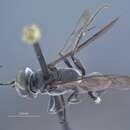Comprehensive Description
provided by Smithsonian Contributions to Zoology
Liris dominicana
HOLOTYPE.—♂, Clarke Hall, Layou Valley, Dominica, 20–28 February 1965 (H. E. Evans), USNM 71367.
Length 7.0 mm; forewing 6.0 mm. Black; fore-wings subhyaline, slightly infuscated along outer margin; hind wings hyaline, slightly darkened apically. Body clothed with pubescence which tends to be somewhat more coarse and suberect than in the preceding species, especially on the propodeum; front and clypeus densely silvery-pubescent; abdomen with apical silvery bands on tergites I–IV, also silvery apically and ventrally.
Mandibles with the upper margin edentate, although slightly sinuate (Figure 11). Clypeus with a moderately broad, truncate median lobe; first four antennal segments in a ratio of 29:7:14:14, segment three 2.3× as long as its apical width; head 1.28× as wide as high; interocular distance at anterior mandibular condyles 2.9× the least interocular distance on the vertex, the latter distance 1.25× as great as the length of the third antennal segment. Sculpturing of thoracic dorsum as described for L. gryllicida, but propodeum notably more elongate than in that species and the posterior declivity less strongly marked off from the disc, there being only some weak, irregular carinae at the junction; median carina of propodeum very short, but followed by a shallow groove that extends over half the length of the disc. Hind tibia weakly ridged above; claws simple. Basal abdominal segment unusually slender, subpetiolate (Figure 6); venter without modification other than some rather coarse pubescence on segments III–V; subgenital plate slightly broader and more distinctly emarginate apically than in L. gryllicida, the genitalia very different from those of that species by virtue of the elongate parameres and the densely setose volsellae (Figure 3).
ALLOTYPE.—♀, Clarke Hall, Layou Valley, Dominica, 10–17 February 1965 (Evans), USNM.
Length 9.0 mm; forewing 7.0 mm. Black; wings subhyaline, slightly more heavily infuscated along outer margin, without yellowish tints. Pubescence of head and thorax silvery, especially dense on front and clypeus, on the pleura and propodeum somewhat more coarse and suberect than in L. gryllicida; abdomen with rather indistinct silvery bands on the apices of the first four tergites.
Mandibles as described and figured for preceding species. Clypeus with a broad median lobe which is subdentate laterally and weakly indented at the midline (Figure 19); first four antennal segments in a ratio of 34:9:18:20. segment three 2.8× as long as its apical width; head 1.3× as wide as high: interocular distance at anterior mandibular condyles 3.4× the least interocular distance on vertex, the latter distance subequal to length of third antennal segment. Features of thorax as in male except median propodeal carina extending for slightly more than half the length of the dorsal surface; front basitarsus with four short pecten spines plus several additional spines; hind tibia with a complete, sharp ridge above; claws simple except toothed at extreme base. Basal abdominal tergite gradually expanded from front to rear, as in male; sternites I–IV rather dull, alutaceous; sternite V somewhat more shining, more strongly punctate; sternite VI shining and strongly punctate; pygidium densely clothed with subappressed, golden spines.
PARATYPES.—4 ♀ ♀, 9 ♂ ♂, Clarke Hall, Layou Valley, February–May (Evans, Steyskal, Jackson, Gagne); 1 ♂, Grand Bay, 8 February 1965 (Evans).
VARIATION.—The females vary in size from 8 to 9 mm, forewing from 6 to 7 mm. The males vary in size from 5 to 7 mm, forewing from 4.5 to 6.0 mm. The major variation to be noted is in the median propodeal carina, which may be very short or may be continued behind as a groove or weak carina nearly to the crest of the declivity.
- bibliographic citation
- Evans, Howard Ensign. 1972. "Bredin-Archbold-Smithsonian biological survey of Dominica: aculeate wasps (Hymenoptera: Scolioidea, Vespoidea, Pompiloidea, Sphecoidea)." Smithsonian Contributions to Zoology. 1-19. https://doi.org/10.5479/si.00810282.115

